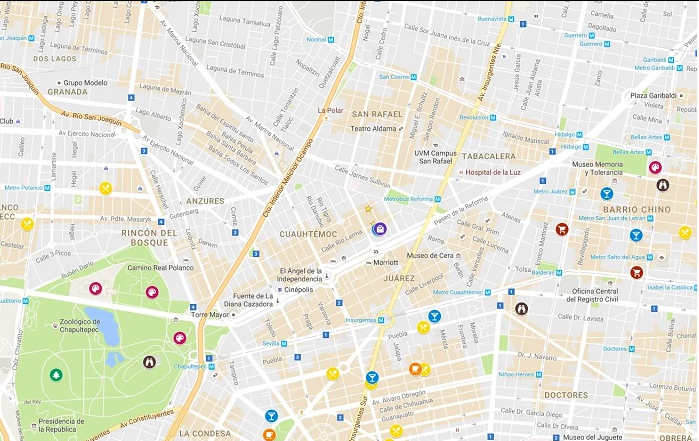Google Maps SEO as Local Business Visibility
In the modern digital landscape, local businesses thrive on visibility, and Google Maps has emerged as a powerful tool for achieving just that. Google Maps SEO is the art of optimizing your business’s presence on Google Maps to ensure maximum exposure to local customers. This concise guide explores the key aspects of Google Maps SEO and how it can propel your business to the forefront of local searches.
1. Google Maps: The Local Search Game Changer
Google Maps has transformed the way consumers search for local products and services. It enables users to discover nearby businesses, read reviews, and get directions seamlessly. Businesses that harness the potential of Google Maps SEO stand a better chance of being discovered by local customers, leading to increased foot traffic, calls, and website visits.
2. Optimizing Your Google My Business (GMB) Listing
Central to Google Maps SEO is your Google My Business (GMB) listing. This free tool allows you to manage your business’s online presence, providing essential information like your address, phone number, business hours, and customer reviews. Optimizing your GMB listing involves ensuring accurate and consistent information, selecting relevant categories, and uploading high-quality photos that showcase your offerings.
3. Navigating Citations and NAP Consistency
Citations, which include your business’s name, address, and phone number (NAP), play a pivotal role in Google Maps SEO. Consistent NAP information across your website, GMB listing, and other online directories enhances your business’s credibility and local ranking. Regularly auditing and updating your citations can prevent confusion and bolster your local SEO efforts.
4. Soliciting Authentic Reviews
Positive reviews not only instill trust in potential customers but also influence your local search ranking. Encourage satisfied customers to leave authentic reviews on your GMB listing. Responding to reviews, whether positive or negative, showcases your commitment to customer satisfaction and can improve your local SEO standing.
5. Localized Content and Keywords
Incorporate localized keywords into your website’s content to enhance its relevance for local searches. Craft landing pages or blog posts that focus on your business’s service areas and target locations. This localized content reinforces your presence in specific geographic areas and aligns with user intent.
6. Building Backlinks from Local Sources
Just as backlinks from authoritative websites impact traditional SEO, local backlinks influence your Google Maps SEO. Collaborate with local influencers, partner businesses, or local publications to earn high-quality backlinks. These backlinks signal to Google that your business is a relevant and reputable local entity.
7. Mobile-Friendly Experience
Given the prevalence of mobile searches, optimizing your website for mobile devices is essential for Google Maps SEO. A mobile-friendly website ensures that users can easily access your business’s information and navigate to your location, enhancing their overall experience.
8. Geo-Tagging and Schema Markup
Geo-tagging your images and implementing schema markup on your website can provide additional signals to search engines about your business’s location. These technical optimizations contribute to better Google Maps visibility.
In conclusion, Google Maps SEO is a potent strategy for boosting local business visibility. By optimizing your GMB listing, managing citations, garnering authentic reviews, creating localized content, building local backlinks, and prioritizing mobile-friendliness, you can position your business prominently on Google Maps and drive valuable local traffic. In the era of localized searches, mastering Google Maps SEO is a key differentiator for businesses seeking to stand out in their communities.
Essential Key Steps To Ranking Higher In Google Maps
Achieving a prominent position in Google Maps can significantly boost your local business’s visibility and drive valuable foot traffic. This concise guide outlines the 10 crucial steps that can propel your business towards higher rankings in Google Maps.Achieving a prominent spot on Google Maps is a game-changer for local businesses. With increased visibility, you can attract more customers and drive foot traffic to your physical location. This concise guide outlines 10 essential strategies that can propel your business toward higher rankings in Google Maps.
1. Optimize Your Google My Business (GMB) Listing: Begin your journey by ensuring your GMB listing is complete and accurate. Provide comprehensive information, including business name, address, phone number (NAP), business hours, and relevant categories. This foundational step primes your business for Google Maps success.Kick off your journey by fine-tuning your GMB listing. Fill in every detail accurately – from your business name, address, and phone number (NAP) to business hours and categories. A complete and precise GMB profile lays a strong foundation for better rankings.
2. Leverage High-Quality Images: Visual content matters. Showcase your business by uploading high-quality images that represent your products, services, and premises. Well-curated photos engage users and provide a glimpse into what your business offers.Captivating visuals leave a lasting impression. Use high-quality images to showcase your products, services, and ambiance. Engaging visuals not only capture users’ attention but also enhance their understanding of what your business offers.
3. Solicit Authentic Customer Reviews: Genuine reviews from satisfied customers not only instill trust but also influence your Google Maps ranking. Encourage patrons to leave honest reviews on your GMB listing. Responding to reviews, both positive and negative, reflects your commitment to customer satisfaction.
4. Consistent Citations and NAP: Ensure uniformity in your business’s Name, Address, and Phone Number (NAP) across all platforms. Accurate and consistent citations bolster your business’s credibility and contribute to higher Google Maps rankings.Consistency in your business’s Name, Address, and Phone Number (NAP) across various platforms reinforces your credibility and boosts Google Maps rankings. Make sure your NAP details are accurate and uniform everywhere.
5. Focus on Localized Keywords: Incorporate location-based keywords in your website content, GMB description, and business categories. This optimization aligns your business with relevant local search queries, enhancing your chances of appearing in Google Maps results.
6. Enhance On-Site SEO: Optimize your website for local search by integrating relevant keywords, meta descriptions, and headers. A well-structured website aids Google in understanding your business’s relevance to local searches.Streamline your website’s SEO for local searches. Incorporate relevant keywords, optimize meta descriptions, and use headers effectively. A well-structured website aids Google’s understanding of your business’s local relevance.
7. Cultivate Local Backlinks: Forge partnerships with local influencers, organizations, and businesses to acquire authoritative backlinks. These local endorsements bolster your business’s credibility and contribute to higher rankings in Google Maps.Forge connections with local influencers, community organizations, and neighboring businesses to gain authoritative backlinks. These endorsements from local sources bolster your credibility and contribute to elevated rankings on Google Maps.

8. Generate Local Content: Create content tailored to your local audience. Craft blog posts, articles, or videos that highlight local events, news, or stories. This content not only resonates with your community but also signals Google’s algorithm about your geographic relevance.Create content that resonates with your local audience. Develop blog posts, articles, or videos that highlight community events, news, or narratives. Tailored content not only engages your audience but also signals Google’s algorithm about your geographic significance.
9. Mobile-Friendly User Experience: In the mobile-centric landscape, a responsive website design is paramount. Ensure your website is optimized for mobile devices, enabling users to easily access information and navigate to your business.
10. Regularly Update Information: Consistently update your GMB listing and website with accurate information, including any changes to business hours, services, or contact details. Staying current reflects your dedication to providing up-to-date information to potential customers. Consistently update your GMB listing and website with accurate information. Any changes to business hours, services, or contact details should be promptly reflected. Regular updates demonstrate your commitment to providing the latest information to potential customers.
11. Embrace Visual Storytelling: Captivating visuals leave a lasting impression. Use high-quality images to showcase your products, services, and ambiance. Engaging visuals not only capture users’ attention but also enhance their understanding of what your business offers.
12. Nurture Genuine Customer Reviews: Positive reviews from satisfied customers resonate with potential patrons and impact your Google Maps ranking. Encourage clients to share their experiences on your GMB listing. Thoughtful responses to reviews, both positive and negative, demonstrate your commitment to customer satisfaction.
13. Localize Your Keyword Strategy: Inject local keywords strategically into your website content, GMB description, and business categories. Tailoring your content to local queries enhances your business’s relevance for Google Maps results.
14. Prioritize Mobile User Experience: In a mobile-driven era, ensuring a mobile-responsive website is non-negotiable. A website that performs seamlessly on mobile devices guarantees easy access to information and directions, enhancing user satisfaction.
To sum up, a higher ranking on Google Maps demands a comprehensive approach. By optimizing your GMB listing, embracing visual storytelling, fostering authentic reviews, maintaining citation consistency, integrating local keywords, refining on-site SEO, cultivating local backlinks, generating compelling local content, ensuring mobile-friendliness, and staying current with updates, you position your business for Google Maps success. In an era where local searches dominate, mastering these strategies can catapult your business to the forefront of local digital discovery.
In conclusion, the journey to ranking higher in Google Maps necessitates a comprehensive approach. By optimizing your GMB listing, embracing high-quality visuals, nurturing authentic reviews, maintaining consistent citations, incorporating localized keywords, enhancing on-site SEO, cultivating local backlinks, generating local content, prioritizing mobile-friendliness, and ensuring regular updates, you position your business for Google Maps success. As consumers increasingly turn to localized searches, mastering these steps can propel your business towards the spotlight in the local digital landscape.
Google Maps ranking factors
Google confirmed they rolled out a massive local engine update. That Vicinity update became the biggest local search algorithm update in the last five years and heavily shifted the balance of the three core ranking factors. In particular, the distance factor started playing a far more important role than it used to. For example, before the update, the listings that were better optimized could easily outperform those that were actually closer to the searcher. As for now, this is hardly possible.
Together with the Vicinity update, Google has started testing the new local pack layout in SERPs. So you may come across a wider block with its map on the right and the three local pack results on the left.Google Maps ranking factors are also called local ranking factors, as they are all related to location, both yours and the searcher’s. According to Google’s documentation, the three main local ranking factors are:
Relevance — how much your business matches the user’s query.
Distance — how close you are to the search user.
Prominence — how well-known and well-liked the business is
Google Maps has revolutionized local business discovery, and understanding its ranking factors is pivotal for local success. This concise guide unravels the core factors that influence your position on Google Maps, enabling you to enhance your local visibility strategically.
1. Google My Business (GMB) Profile Optimization: Your GMB profile forms the bedrock of Google Maps ranking. Craft a detailed and accurate profile, including your business name, address, phone number (NAP), categories, and hours of operation. A complete and optimized GMB profile lays the foundation for higher visibility.
2. Citations and Consistency: Consistent NAP information (Name, Address, Phone Number) across your website, GMB listing, and other online platforms enhances your credibility. Citations from authoritative sources validate your business’s legitimacy and contribute to improved Google Maps rankings.
3. Customer Reviews and Ratings: Authentic customer reviews impact both user trust and Google Maps ranking. Encourage satisfied patrons to leave positive reviews on your GMB listing. Engaging with reviews, responding graciously, shows your commitment to customer satisfaction and boosts your local reputation.
4. Proximity to the User’s Location: The proximity of your business to the user’s location significantly influences Google Maps ranking. Businesses located nearer to the user’s search location are more likely to appear prominently in local search results.
5. Local Keywords and Descriptions: Incorporate location-specific keywords into your website, GMB description, and content. Descriptions that precisely reflect your offerings and service areas enhance your relevance for local searches.
6. Backlinks from Local Sources: Backlinks from local websites, directories, and authoritative sources validate your business’s relevance in the community. Local backlinks contribute to improved Google Maps ranking by establishing your local authority.
7. Click-Through Rate (CTR): A higher CTR indicates that users find your business listing compelling. Engaging titles, descriptions, and images can improve your click-through rate, signaling Google that your listing is relevant and valuable to users.
8. User Engagement and Interaction: Engaged users, such as those who click for directions, call your business, or visit your website, indicate the effectiveness of your listing. Google considers user interactions as a ranking factor for Google Maps.
9. Website Quality and Mobile-Friendliness: A well-optimized, mobile-responsive website reflects positively on your business. Websites that offer a seamless mobile experience and provide relevant information contribute to better Google Maps ranking.
10. Regular Updates and Fresh Content: Keeping your GMB listing and website current with accurate information signals Google that your business is active and engaged. Regular updates and fresh content showcase your commitment to serving customers.
In summation, Google Maps ranking factors coalesce to determine your local business’s visibility. Optimizing your GMB profile, maintaining consistent citations, nurturing customer reviews, emphasizing proximity, incorporating local keywords, securing local backlinks, enhancing CTR, fostering user engagement, prioritizing website quality, and staying current with updates collectively shape your position on Google Maps. As local searches become increasingly prevalent, mastering these factors can propel your business to the forefront of local discovery.






